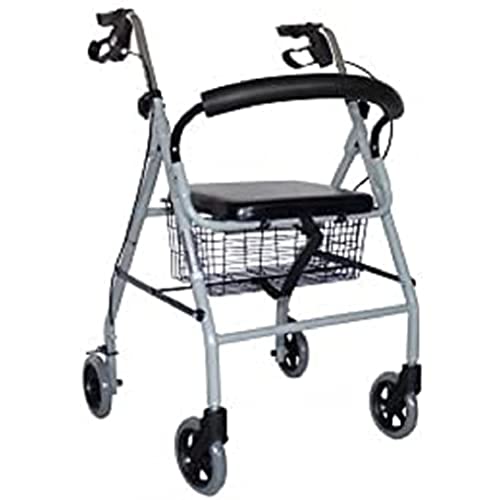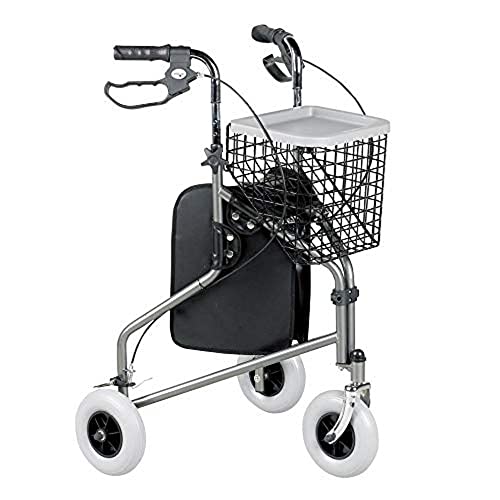You'll Never Guess This Rollator Walking Aid's Secrets
작성자 정보
- Keeley 작성
- 작성일
본문
 What Is a Rollator Walking Aid?
What Is a Rollator Walking Aid?A rollator is a form of walking aid which helps individuals maintain their balance. It helps by increasing the base of support (BoS) while walking.
It has brakes which can be easily engaged, and it is able lock when the user stops or sits on the walker. A comfortable seat as well as an organizer for personal belongings are also included.
Stability
Rollators provide greater mobility and stability compared to traditional walkers. They are a great choice for people who have difficulty keeping their balance or need an upright base for walking. These aids for mobility are designed to ease the strain on muscles and joints and can aid in an earlier recovery.
These devices help reduce the stress on joints in the lower extremities and also reduce strain on the muscles. This is accomplished by spreading the weight across a larger area. This reduces the peak pressure in the forefoot during walking downhill or uneven surfaces. These devices also help to reduce forefoot discomfort by redistributing the pressure of the plantar area onto other areas of your foot.
The frame is a key component of a purple rollator walker's strength because it is able to support the user's weight. The frame is usually constructed of strong materials such as steel or aluminum rollator to ensure that the device won't fall apart or collapse under pressure. The handle brakes are also an additional safety feature on a rollator, helping users slow down or stop if they have gone too fast.
The frame of a walker that rolls is a very stable structure, however it has its limitations. The weight and size of the frame can influence the device's ability to maneuver in different conditions. Certain studies have revealed that the use of a walker with huge wheels causes the center of gravity to shift slightly to the left, which can negatively impact the way the device is utilized.
This is not a problem in the majority of situations however it must be considered when buying a rollator. This is why many professionals recommend that individuals choose a rollator with smaller wheels if they intend to spend a significant amount of time outside or in a variety of walking conditions. The height of the handles is important to ensure they're at the correct height for the user. This will help prevent wrist fatigue and shoulder discomfort.
Support
Rollators are more sturdy than traditional walkers, with a frame to assist the user. They also come with four wheels which distribute weight evenly and help users navigate different terrains without falling. This allows them to remain active both indoors and outdoors and lead a more independent life with more confidence. Rollators can be customized with various features, like adjustable brakes, handles, and wheel sizes to meet particular requirements. Some models are also equipped with a backrest and storage options for everyday comfort and mobility.
While a rollator walker foldable provides better stability, it's vital that you use it in a safe manner to avoid accidents. It is recommended that an expert in physical therapy or a doctor supervise your transition to using a mobility device. They will provide you with an official prescription for the device and suggest the best one for your particular situation.
It is also important to follow the manufacturer's instructions regarding how to use your rollator. This will ensure that it is placed at the right height and is a good fit for your body type. To enhance the functionality of your device, you need to keep it clean and well-lubricated.
When using a rolling walker ensure that you place your weight on the base of the device and not on the wheels. Leaning on the wheels could be a safety hazard and cause it to flip over. Do not let your child rest on top of an aid for mobility. This can cause the wheels to wear out faster because of the pressure.
Cost may deter some people from using an aid for walking. Insurance coverage and financial assistance can help offset the cost. For instance, Medicaid and Medicare classify the rollator or walker as durable medical equipment, which means they will help cover a portion of its cost. Additionally flexible spending accounts (FSAs) and health savings account (HSAs) can be used to pay for these devices as well. A rollator is a useful and affordable tool that lets you to remain self-sufficient and mobile.
User-Friendliness
Rollators are a great choice for those who require extra support, but want to be mobile. It's simple to maneuver and folds easily when not in use. A rollator can help reduce the pressure on muscles and joints and improve balance, which helps with overall walking performance.
A typical rollator consists of a frame with anywhere between two and four wheels. The wheels make it easy to move as it doesn't require lifting the frame each time. Some models even come with seats, so you can relax when needed.
While research is ongoing and ongoing, it is expected that using a walker can reduce the load on certain joints and muscles during walking. This could lead to a decrease in the strength needed for other movements and activities, such as stair climbing or balance control when standing or squatting. This could lead to the risk of falling that is seen in older rollator users.
It is important to find the right walker or lightweight rollator walker that feels comfortable for the user. The handle should be placed at the same height as the knee nearest to it, but away from the body. If you hold a walker too close to the body could cause strain on the neck, back and arms. The grip of a walker that is rolling is also important. If the grip is not comfortable or doesn't meet the individual's preferences then you can replace it with a new style. If the handle is too small or too hard the grip made of foam, plastic or a different soft material might be more comfortable.
It's also important to remember that the walker or rollator must be kept at a safe distance from the floor in order to avoid exerting too much pressure on the feet and legs. This will reduce the chance of tripping and twisting an ankle, knee or foot. It's important to have a backup device (like a cane or crutches) handy in case the rolling walker is unstable due to reasons of any kind. It's not a good idea to leave the rollator on uneven or stair-like floors for prolonged durations of time.
Convenience
A rollator is a convenient mobility aid for those who are unable to walk long distances or who experience frequent falls. It can reduce the impact and strain on injured muscles and joints. It can also boost confidence and increase social interaction. It's important to consider the cost of a rollator as well as how your insurance will cover it. Medicare Part B policies may cover a portion of the cost if you have reached your annual deductible. Medicaid is also a common way to cover these devices.
Some people choose to use a all terrain rollator walker as an alternative to a cane or walker however, it's recommended to continue using these other devices for stability and support while walking. A walker, for example, can help you maintain a straight posture by ensuring that your arms are level with your hips. In addition you can use it in a comfortable and reassuring distance from your body, which helps prevent curious positions that could result in an injured knee or ankle.
It's important to remember that if you choose to use a walker, you shouldn't hold it in front of your body or near. The handlebars of a normal walker usually over the arms of the user, which can cause wrist flexion torque. This can cancel out the flexor muscles of the arms and hands, which can result in forefoot pain or hallux rigidus. A walker that rolls reduces this problem by lowering the handles to a position which is more in line with the processus styloideus ulnae.
Most rollators come with seats that can be used in public places or when doing errands. This is especially useful when you're shopping and want to rest your legs. Some models come with a tray on the top of the seat, which allows you to carry snacks and beverages while you're out and out and about.
Take note of whether the model you choose has a place to store things like your wallet, phone, and keys. Some models are designed with an open-air basket at the front of the frame, whereas others have a storage compartment underneath the seat. Some walkers that roll such as those found at Essential Aids, even have straps for backpacks to make it easy to transport.

관련자료
-
이전
-
다음
댓글 0
등록된 댓글이 없습니다.
